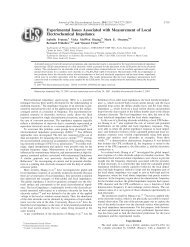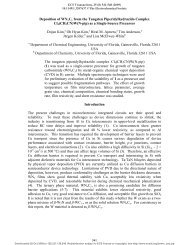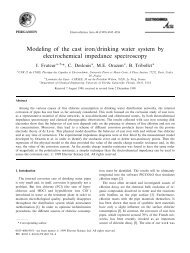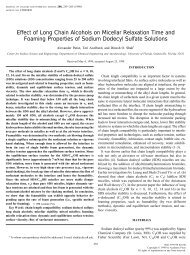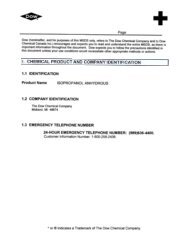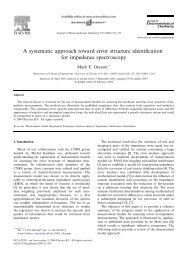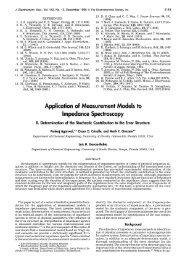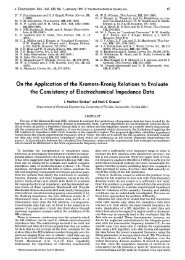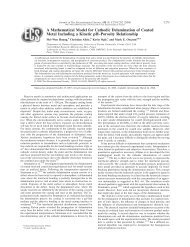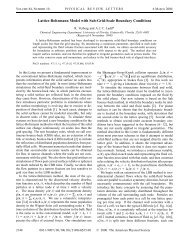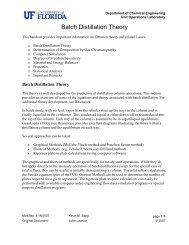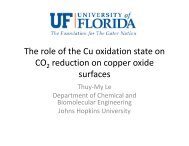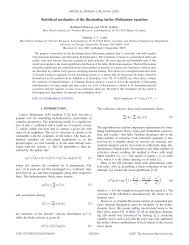Stability of Sodium Dodecyl Sulfate Micelles in the Presence of a ...
Stability of Sodium Dodecyl Sulfate Micelles in the Presence of a ...
Stability of Sodium Dodecyl Sulfate Micelles in the Presence of a ...
You also want an ePaper? Increase the reach of your titles
YUMPU automatically turns print PDFs into web optimized ePapers that Google loves.
7134 J. Phys. Chem. B, Vol. 105, No. 29, 2001 Dhara and Shah<br />
TABLE 1: Sources and Molecular Weights <strong>of</strong> Polymers and Prote<strong>in</strong>s Used <strong>in</strong> This Study<br />
polymer abbrev source avg molecular weight<br />
nonionic<br />
methyl cellulose MC Fisher<br />
hydroxyethyl cellulose HEC PolyScience 90 000-105 000<br />
ethyl(hydroxyethyl) cellulose E230 Akzo Nobel<br />
(Bermocoll E 230 FQ)<br />
ethyl(hydroxyethyl) cellulose E411 Akzo Nobel<br />
(Bermocoll E 411 FQ)<br />
hydroxypropyl cellulose HPC PolyScience low MW<br />
hydroxypropyl methyl cellulose HPMC Aldrich 86 000<br />
hydroxybutyl methyl cellulose HBMC Aldrich<br />
dextran PolyScience 15 000-20 000<br />
poly(ethylene glycol) PEG Scientific Polymer Products 6800<br />
poly(propylene glycol) PPG Aldrich ca. 1000<br />
poly(N-v<strong>in</strong>yl pyrrilidone) PVP Aldrich 10 000<br />
poly(v<strong>in</strong>yl alcohol), 98% hydrolyzed PVA Aldrich 13 000-23 000<br />
poly(acrylamide) PAAm PolyScience 10 000<br />
poly(N-isopropylacrylamide) PNIPA syn<strong>the</strong>sized 23 40 000<br />
anionic<br />
poly(acrylic acid) PAA PolyScience 150 000<br />
poly(acrylic acid), Na salt PAA Na Aldrich 15 000<br />
carboxymethyl cellulose, Na CMC Na PolyScience 80 000<br />
cationic<br />
Quatris<strong>of</strong>t Polymer LM-200 LM-200 Amerchol<br />
(polyquart<strong>in</strong>ium 24)<br />
Polymer JR 400 JR400 Amerchol<br />
(polyquart<strong>in</strong>ium 10)<br />
poly(ethyleneim<strong>in</strong>e) PEI PolyScience 10 000<br />
Figure 1. Mechanism for <strong>the</strong> two relaxation times, τ 1 and τ 2, for a<br />
surfactant solution above critical micelle concentration (cmc).<br />
which takes 50-100 µs. So it is not possible to measure <strong>the</strong><br />
fast relaxation time (τ 1 ) (which is on <strong>the</strong> order <strong>of</strong> microseconds)<br />
with our <strong>in</strong>strument. Moreover, we are ma<strong>in</strong>ly <strong>in</strong>terested <strong>in</strong> τ 2 ,<br />
because it is related to <strong>the</strong> micellar stability. All τ 2 values were<br />
obta<strong>in</strong>ed at 25 °C.<br />
Surface tensions <strong>of</strong> <strong>the</strong> polymer solutions were measured<br />
by <strong>the</strong> Wilhelmy plate method, consist<strong>in</strong>g <strong>of</strong> a plat<strong>in</strong>um blade<br />
suspended from a force transducer with output connected to a<br />
voltmeter for digital display. Before each measurement, <strong>the</strong><br />
plat<strong>in</strong>um plate was cleaned by heat<strong>in</strong>g to a red/orange color<br />
with a Bunsen burner.<br />
Results and Discussion<br />
Dynamic properties <strong>of</strong> micelles are characterized by two<br />
relaxation processes (Figure 1). The first relaxation time (τ 1 ),<br />
which is on <strong>the</strong> order <strong>of</strong> microseconds, is associated with <strong>the</strong><br />
exchange <strong>of</strong> monomers with micellar aggregates. The slow<br />
relaxation time (τ 2 ), which is on <strong>the</strong> order <strong>of</strong> milliseconds to<br />
seconds, is associated with complete formation-dis<strong>in</strong>tegration<br />
<strong>of</strong> micelles. τ 1 and τ 2 are related with two important statistical<br />
parameters <strong>of</strong> <strong>the</strong> micellar system, namely, <strong>the</strong> “residence time”<br />
<strong>of</strong> a surfactant <strong>in</strong> micelles and <strong>the</strong> stability (average “lifetime”)<br />
<strong>of</strong> micelles, respectively.<br />
Figure 2. Effect <strong>of</strong> PEG, MC, and PNIPA on <strong>the</strong> slow relaxation time<br />
(τ 2) <strong>of</strong> SDS <strong>of</strong> different concentrations: (]) SDS only, (0) PEG<br />
(0.01%), (×) PNIPA (0.01%), and (4) MC (0.01%).<br />
Figure 2 shows <strong>the</strong> effect <strong>of</strong> PEG, MC, and PNIPA on <strong>the</strong><br />
slow relaxation time τ 2 <strong>of</strong> SDS micelles <strong>in</strong> <strong>the</strong> concentration<br />
range <strong>of</strong> 50-600 mM. All three polymers are reported to <strong>in</strong>teract<br />
strongly with SDS. 12-16,26-29 In <strong>the</strong> absence <strong>of</strong> polymer, τ 2<br />
showed an <strong>in</strong>itial <strong>in</strong>crease with <strong>in</strong>creas<strong>in</strong>g SDS concentration<br />
but started decreas<strong>in</strong>g above 200 mM. These results are well <strong>in</strong><br />
agreement with previous <strong>in</strong>vestigations. 1,30 The appearance <strong>of</strong><br />
a maxima <strong>in</strong> τ 2 has been expla<strong>in</strong>ed by <strong>the</strong> onset <strong>of</strong> formation<br />
<strong>of</strong> nonspherical micelles. 1 Ano<strong>the</strong>r explanation for <strong>the</strong> occurrence<br />
<strong>of</strong> <strong>the</strong> maximum at 200 mM was provided by Kahlweit<br />
et al. 30 They represent <strong>the</strong> reaction path for <strong>the</strong> formation <strong>of</strong><br />
micelles by two parallel resistors, R 1 and R 2 , where R 1 refers



